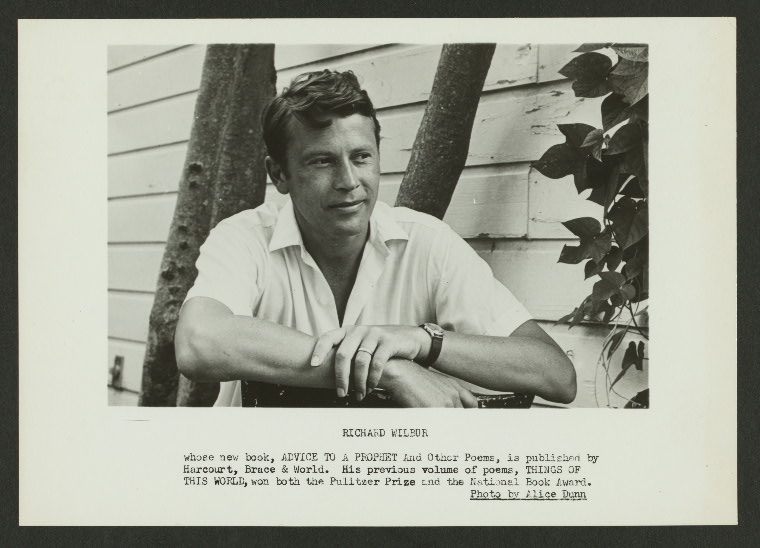Biblio File
Newly Cataloged Richard Wilbur

As a case study, observe how Wilbur evokes dusk in three very different poems: "Cicadas," "As it Is" and "Leaving". The poems exult in rituals both bucolic and urban: a chorus of crickets nestled in leaves with "thick-tongues" break open a still summer night; a city bus ferries passengers hovering over their crossword puzzles through dark streets to their homes; and at a garden party, the tilting shadows of guests saying their goodbyes fade in honeyed light. Wilbur's poetry can be acrobatic; the lines simultaneously restrained and soaring. He writes in verse, but so effortlessly that the reader may not always notice that his lines follow a formal meter. His poetry calls to mind the horsepower and dazzle of a Shawn Johnson balance beam routine: at moments heart-stopping, but with the quiet technical precision required of a narrow run that demands flawlessness. To read Wilbur is to see the world differently, and to appreciate the rhythms and power imposed by meter.
Take the new poem, “The House” , printed in a recent issue of the New Yorker. As with many a Wilbur poem, the narrator explores the liminal state between sleep and consciousness. Here, the "I" of the poem tenderly imagines his lover's dream visions of a white house, and wonders whether she has yet arrived. The poem achieves added poignancy when turning to Wilbur's own life and to to the recent passing of his wife of 65 years, Charlotte Ward Wilbur, in 2007.

Wilbur is a poet that I’ve come to read only recently, in the process of cataloguing a collection of his works acquired from bookseller and bibliophile Robert A. Wilson (1922-), the former proprietor of the Phoenix Book Shop. Virtually all of the Henry A. and Albert W. Berg Collection's printed Richard Wilbur material is inscribed from Wilbur to his friend Bob Wilson.
 Wilson took over the Phoenix at 18 Cornelia Street (later relocated to 22 Jones Street) in 1962, after retiring from a position as office manager at a cuckoo clock factory, and remained there until it closed in 1988. The Phoenix was one of those treasure-rich New York Bookstores frequented and beloved by neighborhood writers living in Greenwich Village, and those like Wilbur who traveled greater distances.
Wilson took over the Phoenix at 18 Cornelia Street (later relocated to 22 Jones Street) in 1962, after retiring from a position as office manager at a cuckoo clock factory, and remained there until it closed in 1988. The Phoenix was one of those treasure-rich New York Bookstores frequented and beloved by neighborhood writers living in Greenwich Village, and those like Wilbur who traveled greater distances.
Regular customers included Marianne Moore, Edward Albee, Ezra Pound, Gary Snyder, Alice B. Toklas, and William S. Burroughs (who inscribed the guestbook with one of his cut-ups). The poet Diane de Prima sometimes worked the counter. Wilson nurtured relationships with his famous customers and published some of their work himself in small editions of poetry under the Phoenix imprint, the Oblong Octavo Series, which he sold at the store.
 The New York Public Library has Oblong Octavo editions of poems by Amiri Baraka, Galway Kinnell, James Merrill, and Louis Zukovsky, among others. For Wilson's own account of his tenure at the Phoenix Book Shop, check out Seeing Shelley Plain (in addition to anecdotes about Moore, Toklas, Pound and others, you'll meet a pair of saber-tooth tigers originally introduced to Wilson by the novelist Glenway Wescott). The Phoenix was enough of a fixture in New York to spur the poet Robert Bly to publish his playful "Pheenix Book Shop List No. 69-Association Items", a tongue-in-cheek list of imagined realia hawked by the store. Bly's list includes an envelope of Tennessee William's moustache clippings and a pork chop bone nibbled on by Allen Ginsberg.
The New York Public Library has Oblong Octavo editions of poems by Amiri Baraka, Galway Kinnell, James Merrill, and Louis Zukovsky, among others. For Wilson's own account of his tenure at the Phoenix Book Shop, check out Seeing Shelley Plain (in addition to anecdotes about Moore, Toklas, Pound and others, you'll meet a pair of saber-tooth tigers originally introduced to Wilson by the novelist Glenway Wescott). The Phoenix was enough of a fixture in New York to spur the poet Robert Bly to publish his playful "Pheenix Book Shop List No. 69-Association Items", a tongue-in-cheek list of imagined realia hawked by the store. Bly's list includes an envelope of Tennessee William's moustache clippings and a pork chop bone nibbled on by Allen Ginsberg.
A good place to start with Richard Wilbur's poetry is his Collected Poems, 1943-2004. Wilbur is also an acclaimed translator of Voltaire, Moliere and Racine. In 1956 the libretto he wrote for Leonard Bernstein's comic-opera version of Candide was produced on Broadway. Wilbur's copy of the Random House edition of the operetta inscribed to Wilson will be on display in the New York Public Library's upcoming exhibition, "Candide at 250: Scandal and Success", opening on October 23. Photo of Robert Wilson by Christopher P. Stephens - September 1979
Read E-Books with SimplyE
 With your library card, it's easier than ever to choose from more than 300,000 e-books on SimplyE, The New York Public Library's free e-reader app. Gain access to digital resources for all ages, including e-books, audiobooks, databases, and more.
With your library card, it's easier than ever to choose from more than 300,000 e-books on SimplyE, The New York Public Library's free e-reader app. Gain access to digital resources for all ages, including e-books, audiobooks, databases, and more.
If you don’t have an NYPL library card, New York State residents can apply for a digital card online or through SimplyE (available on the App Store or Google Play).
Need more help? Read our guide to using SimplyE.
Comments
Wilbur Collection
Submitted by Rodney Phillips (not verified) on January 24, 2022 - 6:31pm